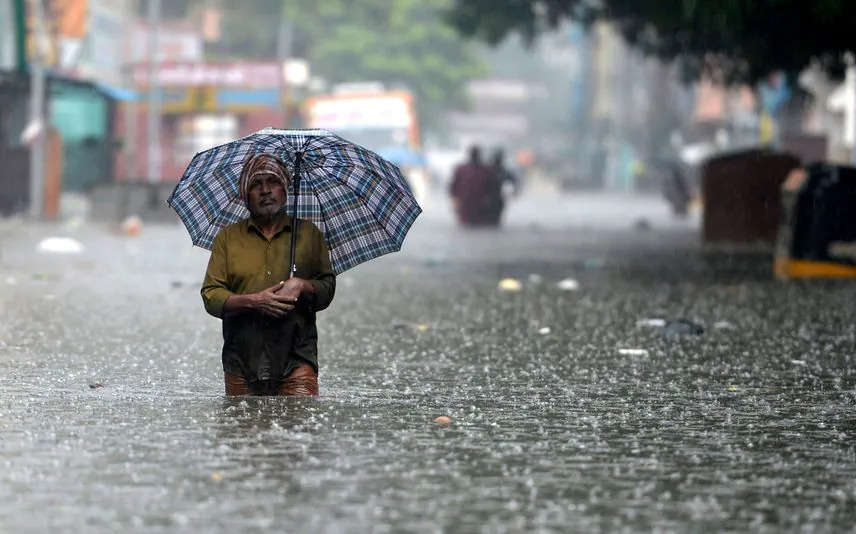Heat Waves and Cyclone Biparjoy Are "Stealing" the Monsoon

Kochi: Last week's Cyclone Biparjoy, which impacted India's northern West coast, brought too much rain to Gujarat and Rajasthan. Nonetheless, it has "taken" the monsoon from states like Karnataka, resulting in a shortfall in rainfall, and has also brought heat waves to many regions of north India, including Uttar Pradesh and Bihar.
Climate change may be making things worse, according to experts. The Arabian Sea's sea surface temperature has increased recently, according to studies, and this has been correlated with a rise in cyclonic storm severity, frequency, and length, as well as highly severe cyclonic storms across the ocean.
Disaster that is Biparjoy
According to its name—"biparjoy" means "disaster" in Bangla—Cyclone Biparjoy has been a calamity in many ways.
High-speed winds and extremely heavy rains caused by Biparjoy, a severe cyclone that first hit Gujarat's coast before weakening into a depression, brought excessive and unusual rainfall to Rajasthan and Gujarat. According to the IMD, Rajasthan has had an excess of 320% rainfall from June 1 while Gujarat has experienced 166%. Gujarat saw more than 40 injuries, according to Livemint. In Saurashtra and Kutch, about 4,500 villages experienced power disruptions.
Madhya Pradesh will experience severe rains, according to the IMD.
Yet in several states, Biparjoy has also postponed the monsoon. According to the IMD, the rain deficit across Uttar Pradesh, Bihar, Jharkhand, Chhattisgarh, Telangana, and Maharashtra has exceeded 80% since June 1. From June 1, Karnataka has seen a 71% deficit in rainfall.
According to IMD officials, Biparjoy has hampered the southwest monsoon's passage over Karnataka. According to A. Prasad, the director of IMD-Bengaluru, Biparjoy has impacted the monsoon wind circulation pattern. But, he added, in the days to come, the monsoon's advance will be encouraged by the currents.
Meanwhile, a heatwave is crippling many northern states. According to the IMD's June 19 warning, several areas of interior Odisha, Jharkhand, and Chhattisgarh as well as some areas of south Bihar saw "Heat Wave to Severe Heat Wave" conditions the day before. The IMD said that there were isolated pockets of heatwave conditions over eastern Madhya Pradesh, eastern Uttar Pradesh, and Gangetic West Bengal, as well as areas of north coastal Andhra Pradesh and Telangana, sections of Vidarbha, and parts of those states.
On June 20, a high-level meeting to assess public health readiness would be presided over by Union Health Minister Mansukh Mandaviya, according to Indian Express. The heat wave conditions over East India and surrounding regions are predicted to "abate gradually" starting on June 20, according to the IMD warning.
Heat waves, the monsoon deficit, and cyclones are all connected.
According to Roxy Koll Mathew, a climate scientist at Pune's Indian Institute of Tropical Meteorology, the presence and progression of Biparjoy, the monsoon rainfall shortfall, and heat waves are all connected.
According to Mathew, the storm has diverted a significant amount of moisture from south, central, and east India's monsoon rains.
"Instead, Rajasthan and Gujarat experienced rain. Because there was no rain and no clouds in the remainder of the region, the heat there was increased, he claimed.
The amount of solar radiation is increased during the daytime when there are no clouds, Matthew continued.
Do these incidents have any connection to climate change?
According to Mathew, during these episodes, "the extra heat from climate change is getting stored (or trapped) in a few locations."
For instance, the present heatwaves being experienced in north India.
According to recent studies, the sea surface temperatures across the Arabian Sea have risen by 1.2°C to 1.4°C in the last four decades compared to those of forty years ago, according to the Hindustan Times. It stated that the strength, frequency, and length of cyclonic storms—particularly very severe cyclonic storms—over the Arabian Sea are all related to warmer oceans. The dynamics of the Indian Ocean are also changing as a result of climate change, according to two recent studies. While fast warming of the ocean's northern sections is exacerbating cyclones, heatwaves in the Indian Ocean are decreasing the amount of rain that falls over central India during the monsoon season.Last year, The Wire Science reported.
.png)